Calls to ‘Sell Singapore, Buy Sri Lanka’ at CCC Economic Summit
“What is clear to me however, from a policy implementation perspective is that the present Sri Lankan economic story is under- told, often distorted and down played,” a top government official told a gathering of business elite at the inauguration of th Sri Lanka Economic Summit organised by the Ceylon Chamber of Commerce (CCC) on Tuesday.
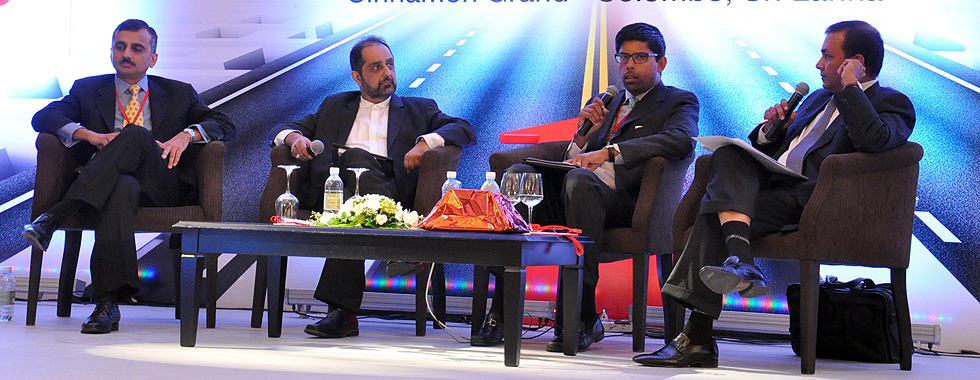
Panel discussion -Boston Consulting Group Managing Director Alpesh Shah, Expolanka CEO Hanif Yusoof, Dilmah Director Malik J. Fernando and Union Bank Chairman Alex Lovell. Pix by M.D.Nissanka
Dr. P.B. Jayasundera, Secretary to the Treasury in his keynote address said that the CCC theme for this year “Sri Lanka 2020 – Towards Surpassing the US$7,000 Per Capita” is indeed a good start, since it is ‘better late than never’ for those with ‘prejudiced and politically biased’ minds to take a pragmatic approach in the interest of nation’s progress. “As Sri Lankans we could be proud of the emerging consensus that the Sri Lankan economy will not only easily consolidate as an upper middle income economy during the next few years but it also has strong prospects to transit to an advanced economy by 2035. When views such as ‘Sell Singapore, Buy Sri Lanka’ have reached public attention and business analysts project our country as ‘Sri Lanka – the new Island of Growth’, I get the impression that people around the world increasingly acknowledge that our national vision – Mahinda Chintana: has been translated into a dynamic – all inclusive development process through credible action.”
‘Governor doing admirable job’
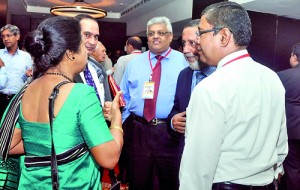
Tea-time conversation
He urged the participants not to worry too much about the exact figure – $7,000 or a slightly higher per capita by 2020. “The per capita income target of $4,000 for 2016 is likely to be a reality in 2015. The Governor – Central Bank and his staff who have done admirable work are quite proud about securing a mid single digit inflation, high external reserves and financial system stability targets – well on track.”
He said that this year, the projected growth is 7.8 per cent and performance in manufactured exports, tourism led services, the construction industry and domestic consumer demand during the first six months of the year is conducive for such growth. The Service Sector is moving beyond 60 per cent of GDP, reflecting value chain growth in primary, secondary and services activities and the structural shift in the economy. Inflation is mid single digit and nominal growth is now driven by a high real growth – a sharp departure from the past when high nominal growth was nothing but attributable to inflation. Year on Year inflation averaged at 4.9 per cent in the first half of the year.
“There is a steady build-up of reserves – now at $9 billion and the Rupee is stable. The buoyant growth in export earnings from goods and services, inflows from tourism and overseas remittances keep the Current Account deficit well financed. There is stability in the Balance of Payments transactions due to buoyant inflows against moderate outflows, providing an environment conducive for
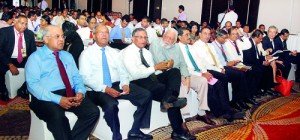
Section of the audience
exchange rate management. The Fiscal Deficit of around 3.7 per cent of GDP in the first half of the year is in line with the annual target of 5.2 per cent. Reduced rates of interest, stable movements in the exchange rates, a lower fiscal deficit complemented by better performance of large State Owned Business Enterprises, parallel with high growth are supportive to further reduce Public Debt to GDP closer to 70 per cent this year.”
All this is indeed music to the ears of macro economists, being goals that have become realities, he said, adding that these are those who attempt to label that these are IMF conditions given to the Government. “I invite them to read ‘Mahinda Chintana’ Vision for the Future’ and the past nine budget statements to understand
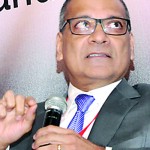
Ajit Gunawardene
how the Government has systematically and successfully implemented a simple homegrown alternative development strategy to what this country followed prior to 2005. Those who are influenced by such ideologies will not agree with the Government. However, what has to be invariable accepted is that if economic progress has been achieved with widespread benefits, then there is all the reason to further consolidate and strengthen that process while giving due attention to any remaining challenges.”
He noted that different views connected to growth are in the air nowadays, as to how business growth and
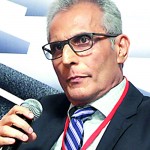
Ashroff Omar
development could be fast-tracked. One view is the need for brand building in the context of promoting export of commodities, services and tourism. “The emphasis of this school of thought is that having a brand that sells in three or four countries cannot be considered as effective branding, if it does not have global presence or is unable to move on with premium product exports.” In relation to the energy sector in which the Government has made rapid progress through bold moves in recent years, views have been expressed that the statistical correlation between GDP growth and growth in electricity, has changed. Dr Jayasundera said that the underlying basis of power generation plans 10-20 years ago was that 1 per cent growth in GDP required 1.55 per cent growth in power supply.
“However in the present context a marginal growth in electricity boosts GDP in big scale. This is attributable to several factors including efficiency improvements associated with the use of electricity, production technologies that are energy efficient, modern architectural and design concepts of factories and buildings enabling energy savings, move towards cost reflective tariffs, energy audits that improve cost efficiency and the overall changing dynamics of energy supply.”
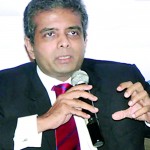
Hans Wijesuriya
Need for new capital market instruments
Dr. Jayasundera said that there is recognition that the issue of shares is not the only way to raise capital, and that a more important role can be played by debt, since the issue of listed debt can even be more competitive that issue of shares. Now there is greater recognition placed on the need for new instruments to make the market more vibrant. “In relation to financing and credit, investment bankers in this country have admitted that they never thought the pawning market was as large as about Rs. 500 billion and effective in the consumer sector.
He said that in the telecommunication sector, key players have been ably broken business barriers and facilitated industries to move towards real growth. “They have observed that in developed countries, every 10 per cent mobile penetration has contributed to 0.6 percent growth in GDP and in developing countries the impact is double. IT/BPO sector has gone into niche markets since comparative advantage could be explored by going up in the value chain.” In this process they look for a larger workforce, IT parks and IT enabled buildings, he said, noting that some are questioning as to why individual universities are not permitted to select students on a criteria they determine, to ensure better output. Similarly in relation to growth, some say that Sri Lanka’s growth is below potential and emphasize on the need for greater external
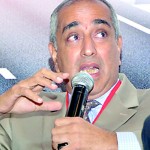
Husein Esufally
integration. “These view s generally reflect that the economy is in a growth mood and everyone is endeavouring to find various growth strategies. This is vital as investment, which is vital factor behind growth must be demand driven and must take place in demanded sectors to be able to cross boundaries. All these are areas that the Government in its policy strategies, has focused in a socially feasible and economically sustainable manner.”
He also pointed out that there are also those who are overly concerned over the tax effort of the Government, in terms of tax to GDP ratio. “Naturally, when nominal GDP increased faster than tax revenue, the ratio falls unless all growth areas are automatically linked to the tax system. On top of this, many growing sectors have tax incentives and exemptions.” Liquor, cigarettes etc. that previously accounted for revenue are contracting and traditional export and import taxes are fast losing their relevance. He said there’s a need to find new avenues to generate revenue and that is why new growth areas need to be promoted. “It is pertinent to note that the 2010 taxation reform strategy was framed targeting low tax and a broad base, while placing emphasis on growth and development.”
It takes time to establish revenue elasticity as it requires the tax structure to be well linked to economic development and expanding activities, he said, adding that alternate choices are there such as keeping high tax rates and a narrow base and runnig loss making state enterprises to subsidise everybody including the business community and the wealth. “If we make this choice, the tax to GDP ratio in the short run may be high but very unlikely to grow steadily as it requires discretionary actions to keep revenue, fueling uncertainty at the cost of economic expansion. Instead, while allowing a long term tax base expansion strategy to work, the Government transformed loss-making large state enterprise such as Ceylon Electricity Board, National Water Supply and Draining Board, Sri Lanka Port Authority and Ceylon Petroleum Corporation that drained public funds as well as bank credit, to be profitable ventures creating valuable lending space for state banks. These adjustments brought about energy efficient industry while also making alternative energy resource development viable in the country while reducing oil imports and improving energy security.”
Do we need roads?
“Several topics of discussion, such as – do we need roads, bridges, expressways, ports, power plants, etc keep surfacing, but those who question the rationale for developing infrastructure are those who wish to see the country remaining to be poor and a lagging-behind nation forever. Neglecting infrastructure would deny well paid decent employment to rural youth. It would deny avenues for farmers to bring their produce to market place,” he said.
Well integrated infrastructure is necessary to make investments viable, create employment, better income and livelihood beyond traditional sources and price stability with increased supply of goods and services, being advancements much sought after by the Central Bank from the structural side for them to make monetary policy work from the demand side, Dr Jayasundera said.
“The Government dispelled through credible actions, the perceived fears of having to print money, excessive debt financing and high debt. Further, assets of certain critical underperforming enterprises were vested in the Government through an Act of Parliament in 2011 enabling their revival dispelling the fear that it was an attempt to take over private property.”
He added that a policy framework was put in place introducing clarity on the policy on alienation of land inter alia to foreigners. Regulations were issued to promote best practices by rationalising charges imposed on importers and exporters and prevent the imposition of Terminal Handling Charges on them.
Dr Jayasundera noted that there are several other structural issues that remain to be addressed, which need to be sequenced and addressed in a manner that would be acceptable from a socio-economic point of view, while also synergising with Government’s long term strategies towards an advanced economy.
Alluding to a comment that the Chairman of Ceylon Chamber of Commerce recently said – if private sector is the engine of growth the public sector should be in the driving seat, Dr. Jayasundera said the driver must be made resourceful through payment of taxes to successfully take the engine forward.


